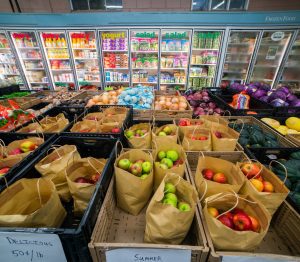
I kicked off my professional career working in a victims crime unit of a police department on the West Coast. If you would have asked me all those years ago that maybe one day I would be working day in and day out to solve the issue of food accessibility and equality in a food desert in an innovative way in my hometown, I would have surely said absolutely not. If you would have asked me if I would be so involved with not only saving food, but turning the profit from that grocery store into community changing programming, I would have most definitely laughed at you and then said NO WAY!
After working in victims crime unit, I moved back to NY and transitioned to substance abuse treatment in an outpatient and home visit based job. For years, before transitioning to working solely in an outpatient treatment setting, I would daily go and visit those in their newly government funded/program approved, unfurnished apartments. It always amazed me that those with so little, would turn hand me downs, or curbside treasures into the most welcoming home environment. The majority of my friends (I always called my clients that, because I never wanted anyone to feel like I looked down on them or found myself to be superior to them due to their life struggles) struggling to stay clean, while also struggling to live independently, no method of transportation, some trying to regain custody of their children, get a job that would keep them out of jail, and oh yeah, figuring out how to feed themselves on a limited SNAP funded or zero income budgets.
I would often pick up food boxes from the various food pantries in our city to deliver to my clients who would run out of food mid month, and then I would be the first phone call they would make when the same food pantries had to turn them down for a second box in that same month because there just wasn’t enough food to give more than one food box. We’d call other pantries in the area, but most went by address, and to find somewhere to give another emergency box was a slim to none chance.
What would I do? I would call the amazing staff at Compassion Coalition, and within minutes they’d get me an emergency food box of healthy, wholesome fresh products to deliver to my clients. The staff at Your Bargain Grocer and I had it down to a science: flash frozen boneless skinless chicken breasts, pasta, milk, fresh farm eggs, butter, a variety of sauces and some fresh and frozen veggies to hold them over until their SNAP benefits came in the first of the month. I appreciated the fact that the team at Your Bargain Grocer would listen to need, and focus on sustainability. I once brought a box to a single Mom and her 2 children, and when they saw fresh salad mixes and fresh apples they began to jump up and down, because it had become a luxury to buy fresh items within their budget at this point in their life.
I would get so frustrated watching this happen month after month, and felt like the conversation needed to be started a long time ago. It’s often easy for those of us running food or emergency related programs for those in need to make recommendations on policy change or issues that we ourselves do not have to deal with or have ever dealt with first hand. We often talk about the struggles of those around us without ever actually consulting with those who actually live it day in and day out, and I believe that’s whats happening with tackling the issue of hunger in America. We all have opinions, but when it comes down to executing the “really good” ideas, we aren’t making change fast enough. We are recycling the same ideas over and over, and getting the same outcomes. We all scratch our heads, as the numbers of those who are needing emergency food boxes in America continue to grow or why the same clients we’ve served for the last decade still need monthly food boxes. When is enough, enough?
After losing numerous clients to the opioid crisis, I made my transition to Compassion Coalition full time to run and oversee community giving and program development in January of 2016. It wasn’t until then that all of my years of experiences with my friends, and the overwhelming issue of food waste in America would hit me like a ton of bricks. 40% of all produced food in America is WASTED, thrown out, perfectly good, edible food! Nearly 50% of all American grown produce is discarded due to aesthetic appearances (too big, too small, slightly mis-shapen), yet I had to watch hundreds of clients living right in Oneida County for many years struggle to feed their families, themselves, and even their pets (yes, they matter too!).
One day I went on a home visit with a client of mine, a single Mom and her young children. My client was meeting all of her goals in great stride, and her child asked for a simple after school snack, and I’ll never forget her response; “you can have the snack now, or save it for tomorrow, but we don’t have enough this week for both”.
These are the stories that continue to aid my desire to see food accessibility and equality come to not only Oneida County, but across the United States. There’s ZERO reason that any person in America should be hungry when we throw out perfectly good, edible food, and don’t bat an eye at the soaring numbers of food waste. Food accessibility and equality is a human right! It’s often hard to change perception and course of how to solve the hunger issue. The answer we usually get from most national donors we petition to join us in selling us their overstock or close dated products is “we should/do give all the overages of food from our business to national or local food banks, or we should give it all to soup kitchens”. Except, no one single program can solve this issue of hunger on their own. We waste and discard enough food in the United States each year that would fill a stack of 18 wheeler tractor trailers that reached 5000 miles into space. All of the food banks in America could not handle the amount of food that is wasted each year in America.We all need to share the sandbox in order to see positive change and conversation start to get the people effected the most the food that they deserve. No person should be void of fresh produce due to socioeconomic status, and no one idea or concept should be the only way of solving the issue, especially when we can’t show the numbers to prove that the model is working. I believe people want to help solve this issue, but they’re not aware of what’s happening within our broken food system. Yes, our entire food system is broken (that’ll be another blog post).
We live in a country that food insecurity (simple meaning is that individuals who are food insecure do not know where their next meal will come from) is an every day problem, yet we’ve been touting the same ideas for the last 20 years with no change. We have national programs taking in 2.2 billion dollars in donated food products, yet we can’t eradicate 1/3 of hunger in America. We in America need to face the facts that the face of hunger has no specific face, and that it can be anyone/anywhere.
So what’s the answer? I have a million answers, I have a million ideas, but I can only concentrate and execute the ideas in my own realm of influence at Your Bargain Grocer and Compassion Coalition. We need to recognize as a nation that the conversation needs to change, and I truly believe that there is a grassroots movement happening in America that is starting.We need to innovate, create, and redesign the way that we are working to solve the hunger issue in America. I often say that we have a hunger issue due to greed and waste.
Our solution is giving food accessibility and equality to ALL in our community, but especially those in our neighborhood of West Utica/Columbia/Lafayette St. What does that mean? That means that we buy and sometimes large companies donate healthy, wholesome product to us that we sell to our communities at highly reduced pricing. It gives a sense of dignity and pride to be able to buy your family healthy food within a budget that you can afford, it also allows those that are struggling in secret to make ends meet have the ability to stretch their food dollars. We then take overstock products that are temperamental (think bananas, avocados, watermelons, etc) and disperse them to area shelters, emergency food workers, and local schools. Should products turn over quickly or during the gleaning process need trimming? We give all scraps to local farmers to do our part to keep the issue of waste moving in a waste reducing recycling process.
Your Bargain Grocer is vehicle that drives our non profit Compassion Coalition. This unique, innovative way that our CEO found to not only combat hunger, but to change a community It’s innovative, creative, and 18 years ago it was an idea that many laughed at. Who would buy close dated, misshapen produce, overstock of frozen product and be successful? Why should you create food accessibility in a food desert when you can go to your local food banks and get it for free? There’s plenty of bodegas and corner stores around! What a crazy idea!
Fast forward 18 years, and we are now seeing non profit grocery stores popup throughout the United States touting the fact that they are bringing food accessibility to those in economically depresses or food desert areas, but what makes Your Bargain Grocer different? It’s changing a community! How? We take the proceeds from our grocery store to sow back into community based giving, each year giving $30,000,000 in donated products through targeted programs in our surrounding communities. Mattress giveaways to those who don’t have beds, snacks to schools whose students are struggling, teacher resource center, cold weather clothing giveaways, and aiding 150+ partner agencies with much needed personal care and sundry products.
We never want to claim to be the only answer, but we want to start the conversation. Join us as we embark on that conversation not only for Oneida County, but for all those who are hungry in America.


Leave a Reply